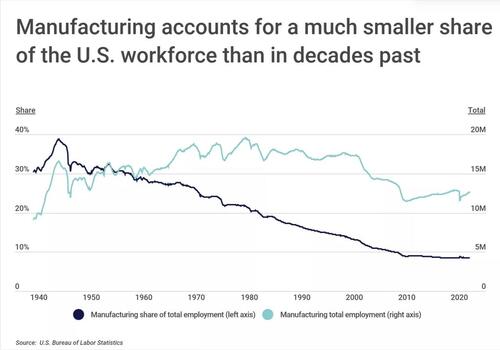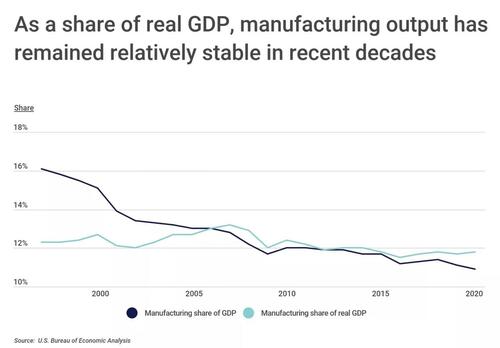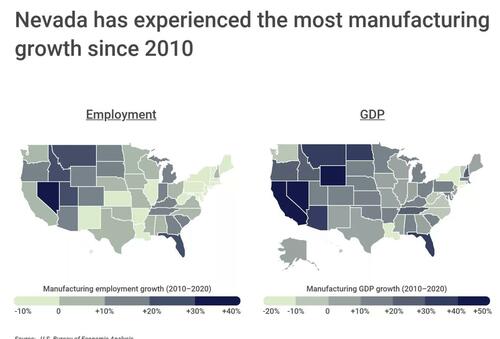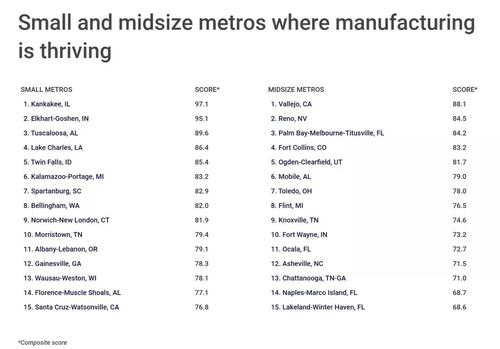
The health of the US manufacturing sector has become a major political issue in recent years. Populist figures like Donald Trump on the right and Bernie Sanders on the left have seized on the supposed death of American manufacturing to criticize the ruling political order.
From former President Trump's focus on trade policy and President Biden’s $1.2 trillion bipartisan infrastructure bill to companies "reshoring" plants for the sake of their supply chains - and for consumers expressing preferences for American-made goods - manufacturing in the US is poised for a comeback, according to one study.
Still, manufacturing in the US represents a much smaller slice of jobs today than it did years ago.
After manufacturing peaked at near 40% of American jobs at the height of World War II, the sector has seen a steady decline over time, to around 8.4% of employment today. In total employment, manufacturing jobs peaked at 19.5 million in the late 1970s and fell off sharply after 2000 to just 12.6 million today.
Interestingly, despite the decrease in manufacturing employment over the past several decades, manufacturing output as a share of real GDP has stayed relatively stable. Since 1997, manufacturing has fluctuated between 11.5% and 13.2% of GDP.
In terms of which states are responsible for the largest growth in manufacturing jobs, Nevada has seen nearly 50% increase in both manufacturing employment in terms of jobs and percentage of GDP from 2010 to 2020, while California has seen a 45.6% increase in manufacturing GDP and Florida has reported an increase of 35.5%.
At the metro level, many of the top locations for manufacturing currently are also found in these states, although a few Rust Belt metros have also enjoyed a resurgence in manufacturing, an industry that they historically saw.
Meanwhile, here's a breakdown of small and midsize metros where manufacturing activity is thriving.
Meanwhile, here's a breakdown of large cities where manufacturing is thriving.
15. Tampa-St. Petersburg-Clearwater, FL
14. Tucson, AZ
13. Orlando-Kissimmee-Sanford, FL
12. San Antonio-New Braunfels, TX
11. Austin-Round Rock-Georgetown, TX
10. Tulsa, OK
9. Phoenix-Mesa-Chandler, AZ
8. Raleigh-Cary, NC
7. Portland-Vancouver-Hillsboro, OR-WA
6. Nashville-Davidson–Murfreesboro–Franklin, TN
5. San Francisco-Oakland-Berkeley, CA
4. Detroit-Warren-Dearborn, MI
3. San Diego-Chula Vista-Carlsbad, CA
2. San Jose-Sunnyvale-Santa Clara, CA
1. Grand Rapids-Kentwood, MI
The health of the US manufacturing sector has become a major political issue in recent years. Populist figures like Donald Trump on the right and Bernie Sanders on the left have seized on the supposed death of American manufacturing to criticize the ruling political order.
From former President Trump’s focus on trade policy and President Biden’s $1.2 trillion bipartisan infrastructure bill to companies “reshoring” plants for the sake of their supply chains – and for consumers expressing preferences for American-made goods – manufacturing in the US is poised for a comeback, according to one study.
Still, manufacturing in the US represents a much smaller slice of jobs today than it did years ago.
After manufacturing peaked at near 40% of American jobs at the height of World War II, the sector has seen a steady decline over time, to around 8.4% of employment today. In total employment, manufacturing jobs peaked at 19.5 million in the late 1970s and fell off sharply after 2000 to just 12.6 million today.
Interestingly, despite the decrease in manufacturing employment over the past several decades, manufacturing output as a share of real GDP has stayed relatively stable. Since 1997, manufacturing has fluctuated between 11.5% and 13.2% of GDP.
In terms of which states are responsible for the largest growth in manufacturing jobs, Nevada has seen nearly 50% increase in both manufacturing employment in terms of jobs and percentage of GDP from 2010 to 2020, while California has seen a 45.6% increase in manufacturing GDP and Florida has reported an increase of 35.5%.
At the metro level, many of the top locations for manufacturing currently are also found in these states, although a few Rust Belt metros have also enjoyed a resurgence in manufacturing, an industry that they historically saw.
Meanwhile, here’s a breakdown of small and midsize metros where manufacturing activity is thriving.
Meanwhile, here’s a breakdown of large cities where manufacturing is thriving.
15. Tampa-St. Petersburg-Clearwater, FL
14. Tucson, AZ
13. Orlando-Kissimmee-Sanford, FL
12. San Antonio-New Braunfels, TX
11. Austin-Round Rock-Georgetown, TX
10. Tulsa, OK
9. Phoenix-Mesa-Chandler, AZ
8. Raleigh-Cary, NC
7. Portland-Vancouver-Hillsboro, OR-WA
6. Nashville-Davidson–Murfreesboro–Franklin, TN
5. San Francisco-Oakland-Berkeley, CA
4. Detroit-Warren-Dearborn, MI
3. San Diego-Chula Vista-Carlsbad, CA
2. San Jose-Sunnyvale-Santa Clara, CA
1. Grand Rapids-Kentwood, MI








